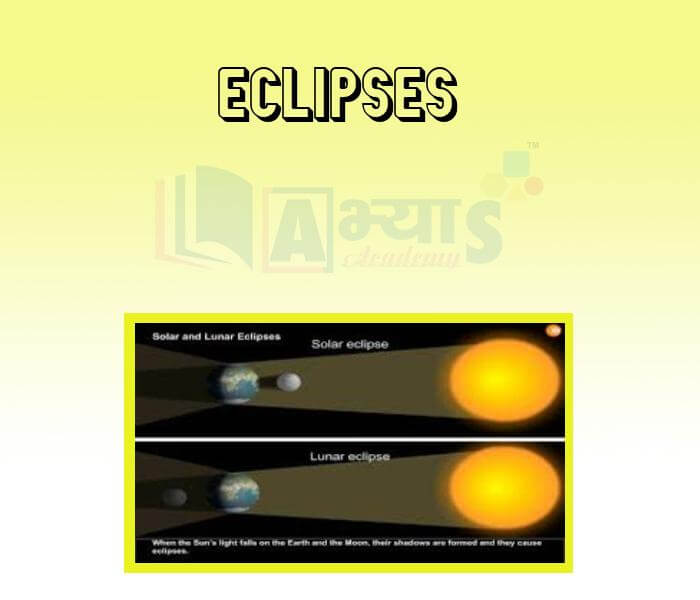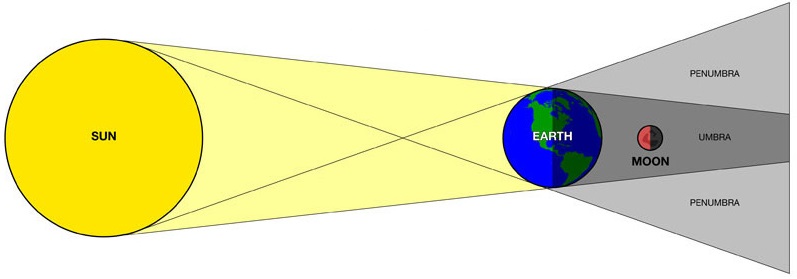Eclipses





Eclipses
The Sun can cast the shadow of the Earth and Moon. This happens when the sun, moon and earth align in a straight line. When the shadow of the Earth falls on the Moon, we cannot see the Moon and this is called lunar eclipse. If the shadow of Moon falls on the Earth, we cannot see the Sun and this is Solar Eclipse.These are examples of shadow formation by heavenly bodies. Let us understand how this happens.
Solar Eclipse:
When the sun, moon and earth are in a straight line, the moon very briefly blocks the light of the sun from reaching earth. In other words, the moon casts its shadow on the earth. On a new Moon day The Moon lies between the Sun and the Earth. On such a day, if they come in a straight line then the shadow of moon falls on the Earth, this phenomenon is known as solar eclipse. Thus, a solar eclipse always occurs on a new moon day.

In the Figure below In the region where the sun will be blocked totally at these places, and a total solar eclipse can be seen. In the rest of the region where the sun will be partially blocked by the moon and a partial solar eclipse can be seen.

Lunar Eclipse:
When the sun, the earth and the moon come in a straight line, with the earth in the middle, the shadow of the earth falls on the moon. On a full Moon night The Sun and Moon are on the opposite side of the Earth. On such a day if they come in a straight line then part or whole of the Moon is not visible to us for some time from some parts of the Earth. This is the case of Lunar Eclipse.

When the Moon is not visible partially, it is called partial lunar eclipse. When the Moon is not visible completely from the Earth we call it a total lunar eclipse. Lunar eclipse always occurs on a full moon night.

Lunar Eclipse occurs when __________________ | |||
| Right Option : B | |||
| View Explanation | |||
A solar eclipse can occur only on a ____________________. | |||
| Right Option : A | |||
| View Explanation | |||
Which of the following are correct ? (a) The Sun can cast the shadow of the Earth and Moon. (b) The Sun can cast the shadow when the sun, moon and earth align in a straight line. (c) When the shadow of the Earth falls on the Moon, we cannot see the Moon and this is called lunar eclipse . | |||
| Right Option : D | |||
| View Explanation | |||
Students / Parents Reviews [10]
Abhyas Methodology is very good. It is based on according to student and each child manages accordingly to its properly. Methodology has improved the abilities of students to shine them in future.

Manish Kumar
10thIt was a good experience with Abhyas Academy. I even faced problems in starting but slowly and steadily overcomed. Especially reasoning classes helped me a lot.

Cheshta
10thBeing a parent, I saw my daughter improvement in her studies by seeing a good result in all day to day compititive exam TMO, NSO, IEO etc and as well as studies. I have got a fruitful result from my daughter.

Prisha Gupta
8thMy experience was very good with Abhyas academy. I am studying here from 6th class and I am satisfied by its results in my life. I improved a lot here ahead of school syllabus.

Ayan Ghosh
8thA marvelous experience with Abhyas. I am glad to share that my ward has achieved more than enough at the Ambala ABHYAS centre. Years have passed on and more and more he has gained. May the centre flourish and develop day by day by the grace of God.

Archit Segal
7thI have spent a wonderful time in Abhyas academy. It has made my reasoning more apt, English more stronger and Maths an interesting subject for me. It has given me a habbit of self studying

Yatharthi Sharma
10thIt was good as the experience because as we had come here we had been improved in a such envirnment created here.Extra is taught which is beneficial for future.

Eshan Arora
8thMy experience with Abhyas is very good. I have learnt many things here like vedic maths and reasoning also. Teachers here first take our doubts and then there are assignments to verify our weak points.

Shivam Rana
7thAbout Abhyas metholodology the teachers are very nice and hardworking toward students.The Centre Head Mrs Anu Sethi is also a brilliant teacher.Abhyas has taught me how to overcome problems and has always taken my doubts and suppoeted me.

Shreya Shrivastava
8thAbhyas is a complete education Institute. Here extreme care is taken by teacher with the help of regular exam. Extra classes also conducted by the institute, if the student is weak.
